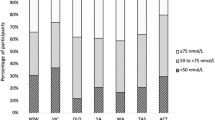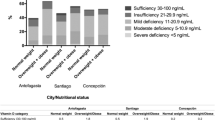Abstract
Background/Objectives:
Vitamin D deficiency in children remains a global concern. Although literature exists on the vitamin D status and its risk factors among children in the Middle East, findings have yielded mixed results, and large, representative community studies are lacking.
Subjects/Methods:
In a nationally representative survey of 1077 Jordanian children of preschool age (12–59 months) in Spring 2010, we measured 25(OH)D3 concentrations by liquid chromatography–tandem mass spectrometry and calculated prevalence ratios for deficiency associated with various factors.
Results:
Results showed 19.8% (95% confidence interval (CI): 16.4–23.3%) deficiency (<12 ng/ml) and 56.5% (95% CI: 52.0–61.0%) insufficiency (<20 ng/ml). In adjusted models, prevalence of deficiency was higher for females compared with males (prevalence ratio (PR)=1.74, 95% CI: 1.22–2.47, P=0.002) and lower for children 24–35 months of age (PR=0.64, 95% CI: 0.44–0.92, P=0.018) compared with children 12–23 months of age. In rural areas, there was no difference in prevalence of vitamin D deficiency between those whose mothers had/did not have vitamin D deficiency (P=0.312); however, in urban areas, prevalence of vitamin D deficiency was 3.18 times greater among those whose mothers were vitamin D deficient compared with those whose mothers were not deficient (P=0.000).
Conclusions:
Vitamin D deficiency and insufficiency pose significant public health problems in Jordanian children with female children disproportionately affected. Strong associations between vitamin D status in children and urban residency and maternal vitamin D status suggest that the behaviors related to sun exposure in urban mothers likely also affect the sun exposure and thus vitamin D status of their children.
This is a preview of subscription content, access via your institution
Access options
Subscribe to this journal
Receive 12 print issues and online access
$259.00 per year
only $21.58 per issue
Buy this article
- Purchase on Springer Link
- Instant access to full article PDF
Prices may be subject to local taxes which are calculated during checkout


Similar content being viewed by others
References
Mithal A, Wahl DA, Bonjour JP, Burckhardt P, Dawson-Hughes B, Eisman JA et al. Global vitamin D status and determinants of hypovitaminosis D. Osteoporos Int 2009; 20: 1807–1820.
Institute of Medicine. Dietary reference intake for calcium and vitamin D. Institute of Medicine: Washington, DC, 2011.
Holick MF . Vitamin D. Modern Nutrition in Health and Disease. 9th ed Baltimore, MD, USA: Williams & Williams, 1999. 329–345.
Holick MF . Vitamin D deficiency. N Engl J Med 2007; 357: 266–281.
Clemens TL, Adams JS, Henderson SL, Holick MF . Increased skin pigment reduces the capacity of skin to synthesise vitamin D3. Lancet 1982; 1: 74–76.
Nesby-O'Dell S, Scanlon KS, Cogswell ME, Gillespie C, Hollis BW, Looker AC et al. Hypovitaminosis D prevalence and determinants among African American and white women of reproductive age: third National Health and Nutrition Examination Survey, 1988-1994. Am J Clin Nutr 2002; 76: 187–192.
Gannage-Yared MH, Chemali R, Yaacoub N, Halaby G . Hypovitaminosis D in a sunny country: relation to lifestyle and bone markers. J Bone Miner Res 2000; 15: 1856–1862.
Holick MF . Environmental factors that influence the cutaneous production of vitamin D. Am J Clin Nutr 1995; 61 (3 Suppl), 638S–645SS.
Baroncelli GI, Bereket A, El Kholy M, Audi L, Cesur Y, Ozkan B et al. Rickets in the Middle East: role of environment and genetic predisposition. J Clin Endocrinol Metab 2008; 93: 1743–1750.
Özkan B, Büyükavci M, Aksoy H, Hüseyin TRA . Incidence of rickets among 0-to-3 year-old children in Erzurum. ocuk Sağliği ve Hastaliklan Dergisi 1999; 42: 389–396.
Underwood P, Margetts B . High levels of childhood rickets in rural North Yemen. Soc Sci Med 1987; 24: 37–41.
Sedrani SH, Al-Arabi K, Elidrissy A . Vitamin D status of Saudis III. Prevalence of inadequate plasma 25-hydroxy vitamin D concentration. Saudi Med J 1992; 13: 214–219.
Bahijri SM . Serum 25-hydroxy cholecalciferol in infants and preschool children in the Western region of Saudi Arabia. Etiological factors. Saudi Med J 2001; 22: 973–979.
Najada AS, Habashneh MS, Khader M . The frequency of nutritional rickets among hospitalized infants and its relation to respiratory diseases. J Trop Pediatr 2004; 50: 364–368.
Gharaibeh MA, Stoecker BJ . Assessment of serum 25(OH)D concentration in women of childbearing age and their preschool children in Northern Jordan during summer. Eur J Clin Nutr 2009; 63: 1320–1326.
Thacher TD, Fischer PR, Strand MA, Pettifor JM . Nutritional rickets around the world: causes and future directions. Ann Trop Paediatr 2006; 26: 1–16.
Dawodu A, Dawson KP, Amirlak I, Kochiyil J, Agarwal M, Badrinath P . Diet, clothing, sunshine exposure and micronutrient status of Arab infants and young children. Ann Trop Paediatr 2001; 21: 39–44.
Olang B, Naghavi M, Bastani D, Strandvik B, Yngve A . Optimal vitamin A and suboptimal vitamin D status are common in Iranian infants. Acta Paediatr 2011; 100: 439–444.
Majid Molla A, Badawi MH, al-Yaish S, Sharma P, el-Salam RS, Molla AM . Risk factors for nutritional rickets among children in Kuwait. Pediatr Int 2000; 42: 280–284.
Dawodu A, Agarwal M, Sankarankutty M, Hardy D, Kochiyil J, Badrinath P . Higher prevalence of vitamin D deficiency in mothers of rachitic than nonrachitic children. J Pediatr 2005; 147: 109–111.
Elzouki AY, Markestad T, Elgarrah M, Elhoni N, Aksnes L . Serum concentrations of vitamin D metabolites in rachitic Libyan children. J Pediatr Gastroenterol Nutr 1989; 9: 507–512.
Roth HJ, Schmidt-Gayk H, Weber H, Niederau C . Accuracy and clinical implications of seven 25-hydroxyvitamin D methods compared with liquid chromatography-tandem mass spectrometry as a reference. Ann Clin Biochem 2008; 45: 153–159.
Jordan Ministry of Health. Global Alliance for Improved Nutrition, United States Centers for Disease Control and Prevention. National Micronutrient Survey: Jordan. 2010–2011.
Nichols EK, Khatib IM, Aburto NJ, Sullivan KM, Scanlon KS, Wirth JP et al. Vitamin D status and determinants of deficiency among non-pregnant Jordanian women of reproductive age. Eur J Clin Nutr 2012; 66: 751–756.
World Climate Guide Jordan Climate Guides (cited 2011 Dec 16). Available from http://www.worldclimateguide.co.uk/climateguides/jordan/.
World Health Organization. WHO Child Growth Standards: Length/height-for-age, weight-for-age, weight-for-length, weight-for-height and body mass index-for-age: Methods and development. Multicentre Growth Reference Study Group: Geneva, 2006.
de Onis M, Blossner M, Borghi E . Global prevalence and trends of overweight and obesity among preschool children. Am J Clin Nutr 2010; 92: 1257–1264.
DeMaeyer EM . Preventing and controlling iron defiency anaemia through primary health care: a guide for health administrators and programme managers. World Health Organization: Geneva, Switzerland, 1989.
Sullivan KM, Mei Z, Grummer-Strawn L, Parvanta I . Hemoglobin adjustments to define anemia. Trop Med Int Health 2008; 13: 1267–1271.
(WHO) WHO. WHO Anthro for Personal Computers Manual: Software for assessing growth and development of the world's children. WHO: Geneva, 2010.
Bursac ZG, Gauss CH, Williams DK, Hosmer DW . Purposeful selection of variables in logistic regression. Source Code Biol Med 1998; 16: 17.
Mishal AA . Effects of different dress styles on vitamin D levels in healthy young Jordanian women. Osteoporos Int 2001; 12: 931–935.
Lammi-Keefe CJ, Jensen RG . Fat-soluble vitamins in human milk. Nutr Rev 1984; 42: 365–371.
Kovacs CS . Vitamin D in pregnancy and lactation: maternal, fetal, and neonatal outcomes from human and animal studies. Am J Clin Nutr 2008; 88: 520S–528S.
Wortsman J, Matsuoka LY, Chen TC, Lu Z, Holick MF . Decreased bioavailability of vitamin D in obesity. Am J Clin Nutr 2000; 72: 690–693.
Cole CR, Grant FK, Tangpricha V, Swaby-Ellis ED, Smith JL, Jacques A et al. 25-hydroxyvitamin D status of healthy, low-income, minority children in Atlanta, Georgia. Pediatrics 2010; 125: 633–639.
World Health Organization Food and Agricultural Organization of the United Nations. Guidelines on food fortification with micronutrients Allen L, de Benoist B, Dary O, Hurrell R eds. World Health Organization: Geneva, 2006.
Abrams SA . Vitamin D requirements in adolescents: what is the target? Am J Clin Nutr 2011; 93: 483–484.
Acknowledgements
The current survey was funded through a grant agreement between the Global Alliance for Improved Nutrition (GAIN) and the Government of Jordan Ministry of Health, and through a Memorandum of Understanding between GAIN and CDC. We especially acknowledge Usha Manadava (deceased) and Rosemary Schleicher for their laboratory support, and Faruq Zghol, Iyad Hamzeh, and Ashraf Mettlaq for helping in the vitamin D laboratory analyses. We would also like to thank Hanan Masa’d, Rawhieh Barham, Aktham Haddadin, Tarek Al-Sanouri, Mohammed Tarawaneh, Bassam Hijawi, Nadera Al-Shareff, Ruba Nabulsi and the many individuals who assisted in the completion of the micronutrient survey.
DISCLAIMER
The findings and conclusions in this report are those of the authors and do not necessarily represent the official position of the Centers for Disease Control and Prevention.
Author information
Authors and Affiliations
Corresponding author
Ethics declarations
Competing interests
The authors declare no conflict of interest.
Rights and permissions
About this article
Cite this article
Nichols, E., Khatib, I., Aburto, N. et al. Vitamin D status and associated factors of deficiency among Jordanian children of preschool age. Eur J Clin Nutr 69, 90–95 (2015). https://doi.org/10.1038/ejcn.2014.142
Received:
Revised:
Accepted:
Published:
Issue Date:
DOI: https://doi.org/10.1038/ejcn.2014.142
This article is cited by
-
Risk factors for vitamin A and D deficiencies among children under-five in the state of Palestine
Conflict and Health (2018)



